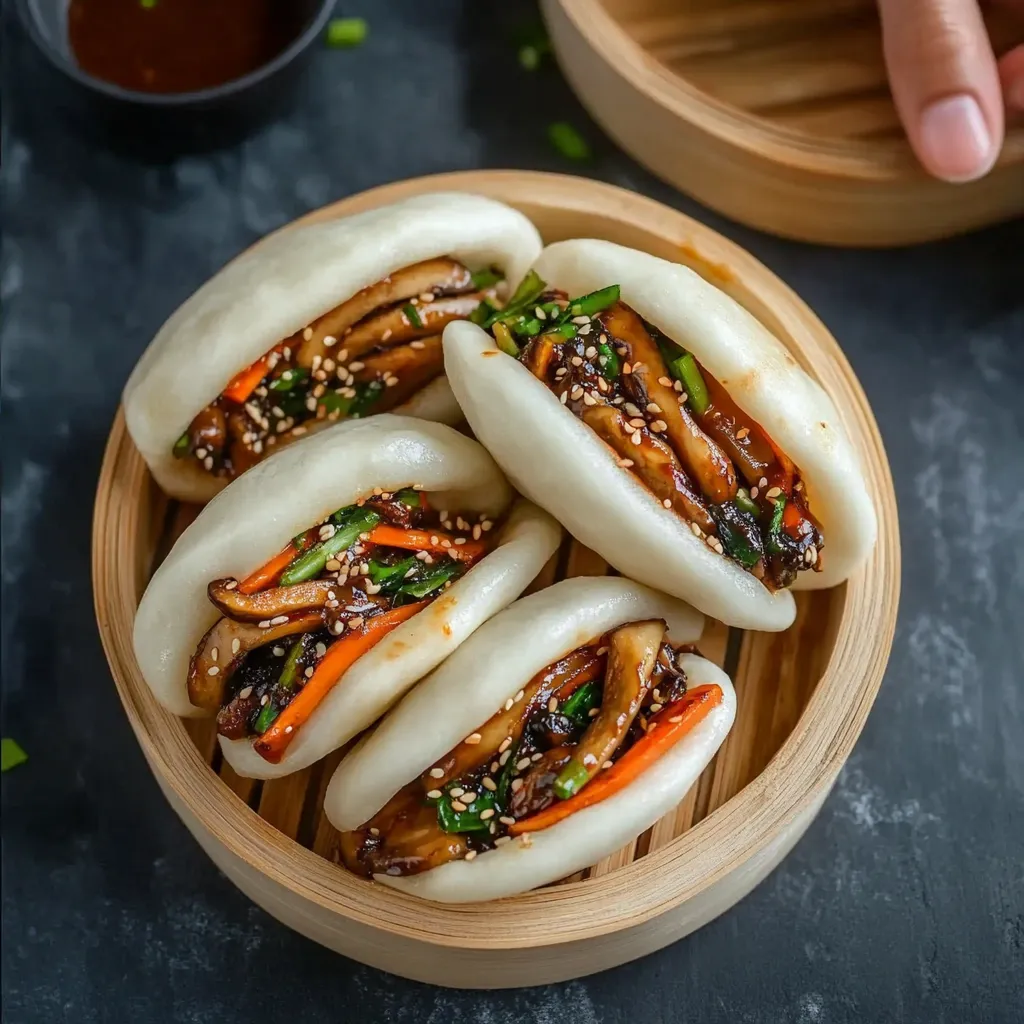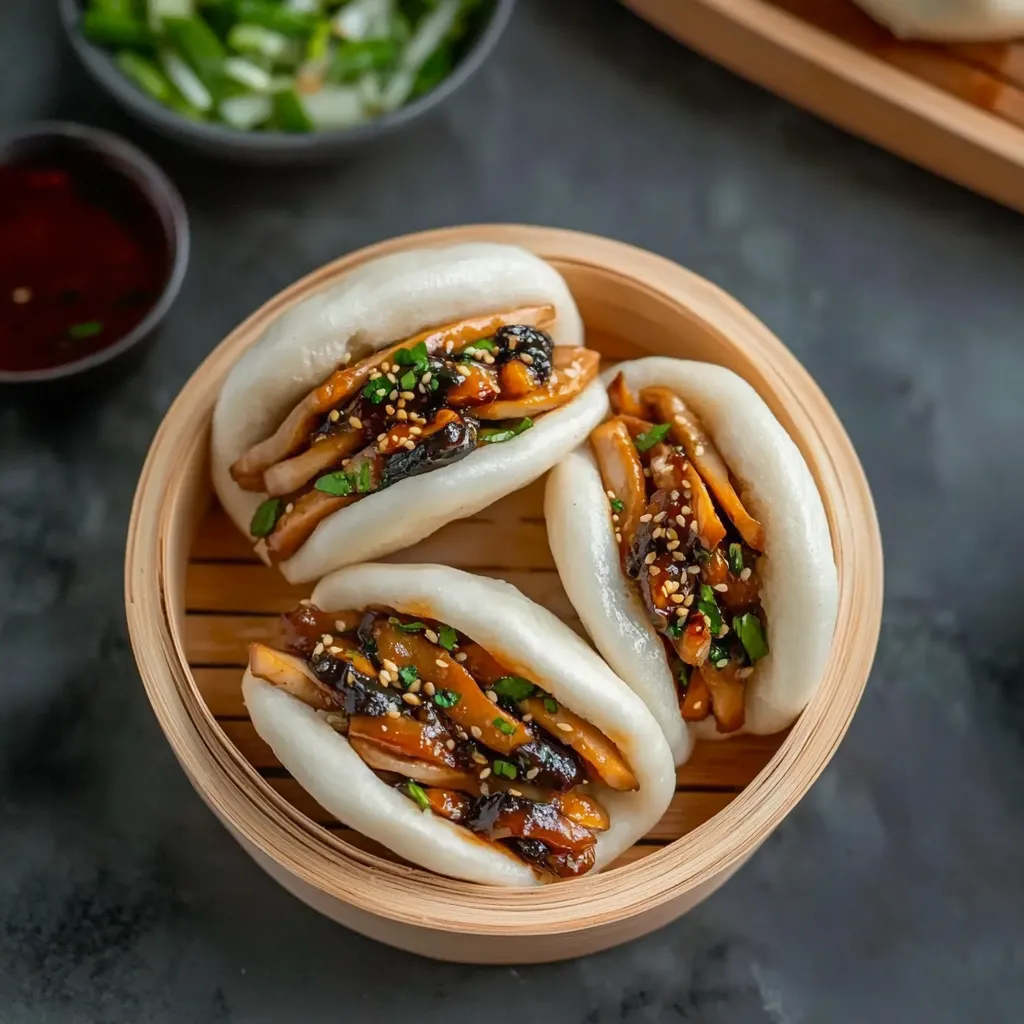 Pin it
Pin it
This fluffy homemade gua bao recipe features pillowy steamed buns filled with savory hoisin mushrooms, tangy pickled vegetables, and your favorite toppings. The contrast between the soft buns and the umami mushroom filling creates an irresistible handheld delight that's perfect for casual dinners or impressive appetizers.
I first made these gua baos for a family gathering where several guests had dietary restrictions. Everyone was amazed that something so delicious could be completely plant-based. Now they're requested at every gathering, regardless of who's attending.
Ingredients
- All purpose flour: Creates the perfect fluffy texture for authentic bao buns
- Corn starch: Helps achieve that characteristic tender steamed bun quality
- Soy milk: Adds subtle flavor and richness while keeping the recipe vegan
- Fresh mushrooms: Provide meaty texture and absorb the savory hoisin marinade beautifully
- Hoisin sauce: Delivers that classic sweet and savory Asian flavor profile
- Rice vinegar: Brings the perfect tangy balance to the quick-pickled vegetables
- Chinese five spice powder: Adds complex aromatic notes to the mushroom filling
Step-by-Step Instructions
- Prepare the Quick Pickles:
- Start by thinly slicing cucumbers and carrots. For best results, salt them for 10 minutes to draw out excess moisture, rinse, then toss with rice vinegar, sugar and salt. The pickles can be made a day ahead for more flavor development.
- Mix the Dough:
- Combine flour, cornstarch and salt in a large bowl. Warm soy milk to approximately 110°F, then add sugar and yeast, allowing it to activate for 10 minutes until foamy. Pour this mixture plus oil into the dry ingredients, then knead for 5 to 10 minutes until smooth and elastic.
- First Rise:
- Shape dough into a ball and place in a bowl covered with a damp towel. Allow to rise for about 1 hour or until doubled in size in a warm spot. This slow rise develops flavor and proper texture.
- Shape the Buns:
- Punch down the risen dough and form into a ring. Cut into 12 equal pieces, keeping them covered while working. Roll each piece into an oval shape, brush with oil, then fold in half. Place on parchment paper squares inside your steamer, allowing them to proof for another 15 to 20 minutes.
- Steam the Buns:
- Place bamboo steamer over boiling water, ensuring water doesn't touch the buns. Steam for 8 to 10 minutes over medium heat. After steaming, keep lid closed for 10 minutes before removing buns. This prevents the sudden temperature change that causes deflation.
- Prepare the Filling:
- Sauté minced garlic until fragrant, then add sliced mushrooms. Pour in hoisin sauce, maple syrup, and Chinese five spice powder. Cook for 5 to 6 minutes until mushrooms are tender and sauce has thickened slightly, creating a glossy coating.
- Assemble and Serve:
- Gently open each fluffy bun and fill with hoisin mushrooms, pickled vegetables, and optional toppings like kimchi, chopped peanuts, and green onions. The combination of soft bun, savory filling, and crunchy toppings creates the perfect bite.
 Pin it
Pin it
My favorite part of this recipe is watching first timers take their initial bite. The look of surprise at how such simple ingredients transform into something so incredibly delicious makes all the effort worthwhile. My daughter now helps me fold the buns, turning our gua bao making into a cherished weekend tradition.
Troubleshooting Your Bao Buns
Achieving perfectly fluffy bao buns can sometimes be tricky. If your buns deflate after steaming, the likely culprit is temperature shock. Always keep the lid on for 10 minutes after turning off the heat. If your buns appear doughy in the center, they need more steaming time. For beginners, I recommend starting with a slightly lower temperature and longer steaming time rather than the reverse.
No Bamboo Steamer? No Problem
While a bamboo steamer creates the most authentic results, you can use alternative methods. A metal steamer basket lined with parchment paper works well. Even a heat-proof plate set on an elevated rack inside a covered pot can function as an improvised steamer. The key is ensuring the water doesn't touch the buns and maintaining a steady steam environment throughout cooking.
Versatile Filling Ideas
The beauty of gua bao lies in its versatility. Beyond the hoisin mushrooms, consider trying maple-glazed tofu, five-spice tempeh, or jackfruit braised in soy sauce and star anise. For non-vegetarians, traditional fillings include braised pork belly or shredded duck. Whatever filling you choose, the balance of sweet, savory, and tangy elements creates the most satisfying combination.
 Pin it
Pin it
Gua bao originated in Fujian province, China, but has become a beloved street food throughout Taiwan and now globally. This adaptation maintains the spirit of traditional gua bao while offering a plant-based twist that everyone can enjoy. The contrast between the pillowy steamed bun and flavorful filling creates a textural experience that truly satisfies the senses.
Frequently Asked Questions
- → Can I make the bao buns ahead of time?
Yes! The steamed buns freeze exceptionally well. Place cooled buns in a freezer-safe container, separated by parchment paper to prevent sticking. When ready to eat, steam them directly from frozen until they're soft and fluffy again, no thawing required.
- → What's the best type of mushroom to use?
A mix of king oyster and shiitake mushrooms works beautifully as they have meaty textures and absorb flavors well. However, you can use any mushrooms you prefer or have available. Button, cremini, or oyster mushrooms are also excellent options.
- → Can I make these without a bamboo steamer?
Absolutely! You can use a metal steamer basket lined with parchment paper, or create a steaming setup with a large pot and heat-proof plate. Place the plate on an elevated surface (like a small bowl turned upside down) inside the pot with water below it, then cover with a lid to trap the steam.
- → Why did my buns deflate after steaming?
Buns typically deflate due to rapid temperature changes. Always let the steamed buns sit covered for 10 minutes before opening the steamer. Also, maintain a medium heat while steaming—too high heat can cause rapid inflation followed by deflation, while too low heat might leave them undercooked.
- → Can I substitute the hoisin sauce with something else?
If you don't have hoisin sauce, you can make a substitute with 2 tablespoons of soy sauce, 1 tablespoon of peanut butter, 1 teaspoon of honey or maple syrup, and a pinch of five-spice powder. Alternatively, black bean sauce or teriyaki sauce can work as flavorful substitutes with some adjustment to sweetness.
- → What can I use instead of soy milk in the dough?
Any plant milk works well for the dough. Almond milk, oat milk, or regular dairy milk can be substituted in equal amounts. Just ensure it's warmed to the proper temperature for activating the yeast.
